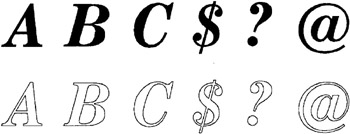Concepts
About Fonts
Some specialized terms are associated with font characteristics. The capline of a font is the highest point of a normal uppercase letter. The baseline is the line upon which the characters rest. The font maximum is the highest vertical coordinate in a font. The font minimum is the lowest vertical coordinate in a font. Figure 32.1 on page 940 illustrates these GFONT procedure terms:

Figure 32.1: Parts of a Font
Specialized terms also exist for types of fonts. The term uniform font refers to a font in which all of the characters occupy exactly the same amount of space, even though the characters themselves are different sizes. Each character in a uniform font is placed in the center of its space, and a fixed amount of space is added between characters. A proportional font is a font in which each character occupies a space that is proportional to its actual width (for example, m occupies more space than i). The characters in a stroked font are drawn with discrete line segments or circular arcs. Figure 32.2 on page 941 illustrates a stroked font with several characters from the Simplex font.

Figure 32.2: Characters from a Stroked Font
Figure 32.3 on page 941 illustrates two types of polygon fonts : filled (CENTBI) and outline (CENTBIE). A filled font is a polygon font in which the areas between the lines are solid. An outline font is a polygon font in which the areas are empty.

Figure 32.3: Filled and Outline Characters from Polygon Fonts
All font characters, regardless of whether they are stroked or polygon, are drawn with line segments. In the GFONT procedure, the term line segment means a continuous line that can change direction. For example, the letter C in Figure 32.2 on page 941 is drawn with one line segment, while the letter A can be drawn with two.
Polygon characters can also be drawn with one or more line segments. In a polygon font, one character can be made up of a single polygon, multiple polygons, or polygons with holes. For example, the letter C in Figure 32.3 on page 941 is a single polygon with one line segment. The question mark (?) is made up of two polygons, each drawn with a separate line segment. The letter A is one polygon with a hole in it. It is drawn with one line segment that is broken to form the outer boundary of the figure and the boundary of the hole.
About the Libref GFONT0
The GFONT procedure stores user-generated fonts in the location that is associated with the libref GFONT0. Therefore, before you create a font or display a user -generated font, you must submit a LIBNAME statement that associates the libref GFONT0 with the location where the font is to be stored, as follows :
libname gfont0 ' SAS-data-library ';
Since the GFONT0 library is the first place that SAS/GRAPH software looks for fonts, you should always assign that libref to the library that contains your personal fonts. If for some reason you have personal fonts in more than one SAS data library, assign them librefs in the sequence GFONT0, GFONT1, GFONT2, and so forth. The search for entries terminates if there is a break in the sequence; the catalog GFONT1.FONTS is not checked if the libref GFONT0 is undefined . If the libref GFONT0 is not defined, by default SAS/GRAPH software begins searching for fonts in SASHELP.FONTS.
To cancel or redefine the libref GFONT n , submit the following statement:
goptions reset=all fcache=0;
Note that when you specify RESET=ALL, all graphics options are reset to their default values. Once you have cleared the font cache, you can redefine the libref with another LIBNAME statement.